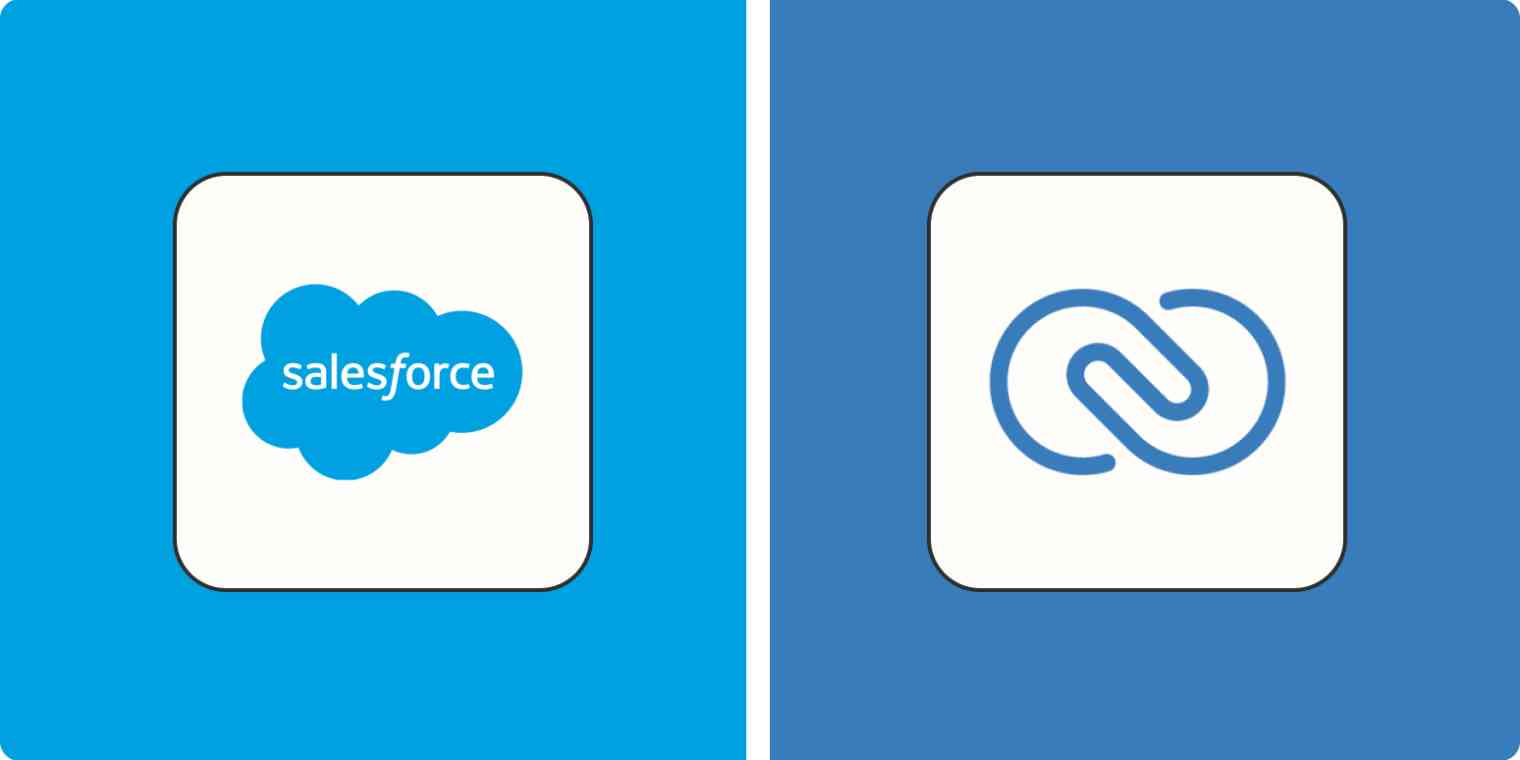Managing customer relationships can be complicated, but the right CRM should help your teams tackle customer interactions and internal workflows more efficiently and more effectively.
If you're deciding between Zoho vs. Salesforce, one isn't categorically better than the other—it's that one may be categorically better for a certain type of need.
Salesforce is renowned as a premium, imminently scalable product, while Zoho is known as one of the best values in the industry in terms of cost per user.
To dig a bit deeper, I tested both CRMs in depth to get a sense of where else they diverged. Based on that experience, here's how they compare.
Zoho vs. Salesforce at a glance
Zoho and Salesforce both have a wide range of products, but to keep this comparison as focused as possible, I looked specifically at Zoho's flagship CRM product and Salesforce's Sales Cloud. Here are the main differences:
Zoho offers a simple but capable solution for managing customer relationships at a value price, while Salesforce is a premium option equipped with more complex features.
Zoho is better suited to pure task and issue management, while Salesforce isn't quite as user-friendly for those specific use cases.
Both platforms have other products beyond their base sales-grade CRM that users can integrate to expand their utility, though Salesforce's network of integrations is much broader.
Both options now have AI assistants, but Salesforce's AI assistant has more generative capabilities.
| Salesforce Sales Cloud | Zoho CRM |
|---|---|---|
Value | ⭐⭐⭐ Starter Suite ($25/user/month), Professional ($80/user/month), Enterprise ($165/user/month), Unlimited ($330/user/month), Einstein 1 Sales ($500/user/month) | ⭐⭐⭐⭐⭐ Standard ($14/user/month), Professional ($23/user/month), Enterprise ($40/user/month), Ultimate ($52/user/month) |
Overall functionality | ⭐⭐⭐⭐ Salesforce is a little clunkier than other premium CRMs, but its overall software quality is still outstanding | ⭐⭐⭐ The user experience of Zoho can be a little uneven, which is reflected in its lower price tag |
Task and issue tracking | ⭐⭐⭐ Salesforce isn't the best day-to-day task management CRM, and it doesn't have dedicated native issue tracking modules like Zoho | ⭐⭐⭐⭐ Zoho's task manager is housed in its most attractive interface (the Projects dashboard), and issue tracking gets its own distinct module |
Scalability | ⭐⭐⭐⭐⭐ With thousands of applications, an impressive suite of cloud products, and lots of premium options for growing enterprises, Salesforce can keep up with any business need | ⭐⭐⭐⭐ While many brands use Zoho's enterprise-level offering, some may find its capabilities limiting at scale compared to premium options like Salesforce |
Automation | ⭐⭐⭐⭐ Salesforce is a very capable automation platform at premium levels, but lower-tier users will likely be disappointed with its capabilities | ⭐⭐⭐⭐ Zoho has decent automation triggers for common tasks and workflows, but its sequence designer is somewhat tricky |
AI | ⭐⭐⭐⭐ The Einstein Assistant is well integrated with useful generative AI | ⭐⭐⭐⭐ Zoho's well-established AI assistant is cheaper than Salesforce's |
Zoho offers a better value for basic users
Zoho's key strength isn't really its strength, per se, but its strength relative to its cost (and its competitors' costs). For smaller businesses that just need a capable CRM, Zoho can do a little bit of everything fairly well. From importing data, designing workflows, and following customer journeys to reporting, automation, and even AI, Zoho lives up to its reputation as a solid value.
Lead management and nurturing may be two of the most important CRM features for most users, and Zoho handles them appropriately. For as little as $14 per user per month, you get all the tools you need to manage sales cycles with tools like:
Centralized contact, lead, and customer data collection
Automated task scheduling
Multiple sales pipelines
Rule-based lead scoring parameters
Forecasting and campaign analytics
Rule-based workflow automation
Custom dashboards
Email templates and mass sends
Higher-tier packages come with additional automation tools for marketing and project management, more dynamic reporting, additional customization capabilities, AI access, and enhanced business intelligence—all for a maximum cost of $65 per month per user (if you go monthly instead of annually). That's pretty remarkable for a CRM.
Pricing for Salesforce can be a little slippery, since it's got a huge range of use cases, but for the purposes of this comparison, Sales Cloud starts at $25 per user per month with no discount for annual billing. With said Starter package, you get a pretty similar baseline to Zoho's Standard equivalent for tasks like contact and lead management, process automation, mass emailing, email templates, and basic custom reporting.
Disappointingly, this Salesforce tier lacks some pretty desirable features despite costing $11 more per user per month (on an annual basis). Forecasting, lead scoring, and even the ability to view customers as individual people are all missing, giving Zoho a pretty clear edge in the value department for users looking for the most bang for their proverbial buck. For example, if you want to score leads, you'll need a $330 package in Salesforce (or purchase it separately after paying up for the $165 tier), compared to just $14 for Zoho.
Salesforce's functionality is generally more sophisticated
Most Salesforce users don't come to the product for its value—they come to it for its reliability, utility, and overall quality. Salesforce has a longstanding reputation for offering one of the best CRMs (among many other SaaS products) on the market.
That said, Salesforce's dashboard isn't the most modern-looking one out there, though it is a little easier to navigate and a bit more polished than Zoho's. Applications are generally more responsive, the look is sharper, and the overall feel is more dynamic.
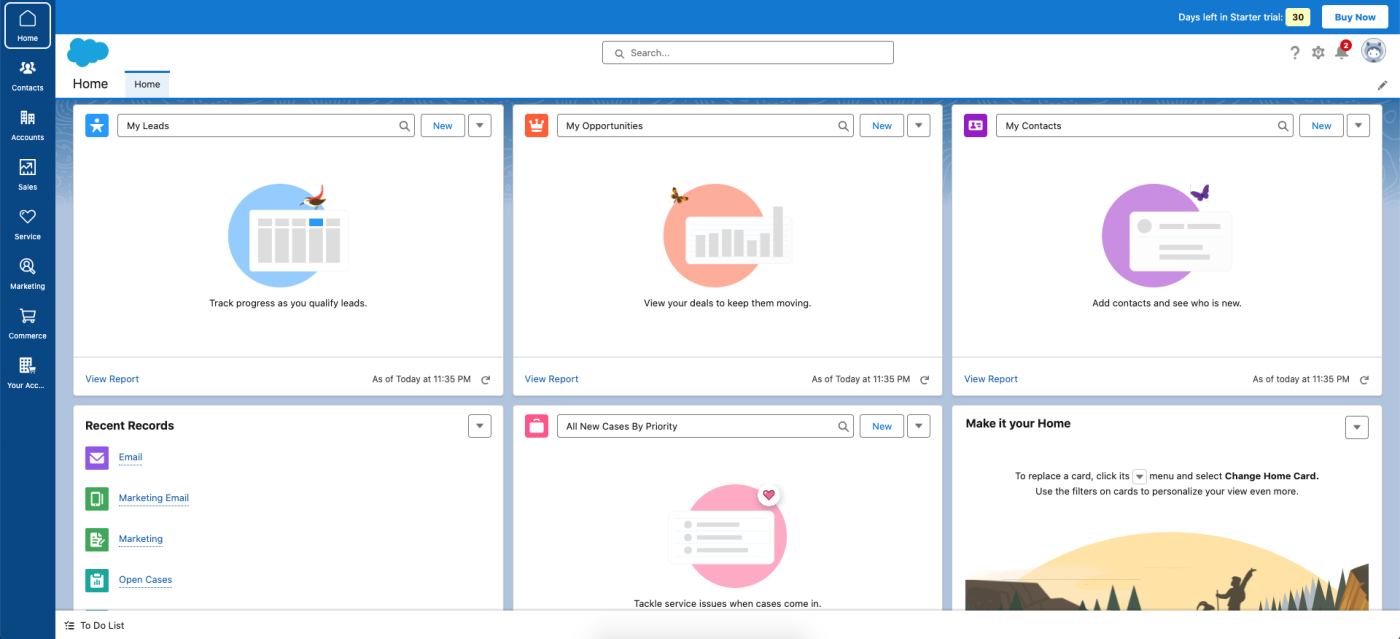
As I noted in my HubSpot vs. Zoho comparison, navigating Zoho can be a little tricky. I had to do a little digging around to find what I wanted, and the main dashboard functionality just feels scrappier than Salesforce's.

On an application level, Salesforce clicks a little easier for me in terms of how I'd expect to integrate it into a typical workflow. For example, let's say I want to add a new lead and start creating a sequence around that lead. Once I fill in all the usual data to set up the profile, I'm taken to a slick little dashboard where I can start adding tasks, events, and contact logs.

It's not that Zoho's version of this doesn't do similar things—it's just that it's not as intuitive. Creating a new contact still takes you to a dashboard where you can add tasks or send communications, but the overall workflow is less inclusive and dynamic. I much prefer how Salesforce gives you more options with a clearer presentation, rather than hiding action options behind dropdowns that only show up when you select a contact.
Plus, contact outreach in Zoho is only carried out within their decent-but-limited native messaging app, while Salesforce allows you to use the native app or integrate Outlook or Gmail right from the dashboard. (Though Zoho gets a plus here for allowing you to distinguish between leads and contacts in separate tabs.)
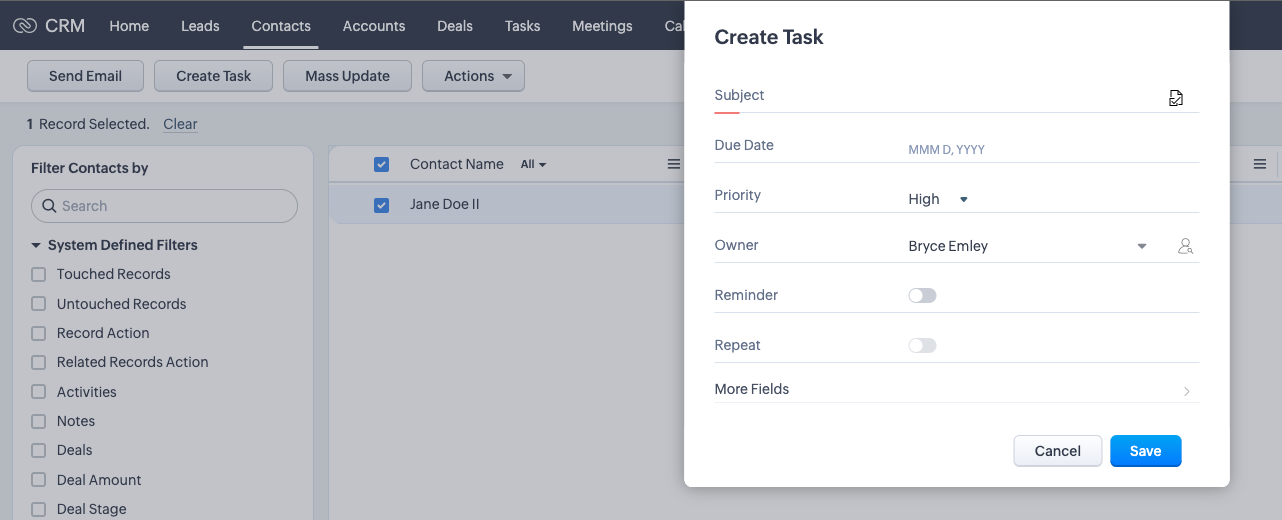
This is obviously a pretty specific example within a much more complex set of software, but I think it's a pretty sound representation of how the two differ in terms of user-friendliness.
Zoho may be better for basic task management and issue tracking
Most of what I said in the above section about the limitations of Zoho's design and general functionality doesn't apply to its Projects dashboard, which houses tasks like ticketing. This dashboard is much sleeker and more responsive than the primary dashboard and module interfaces.
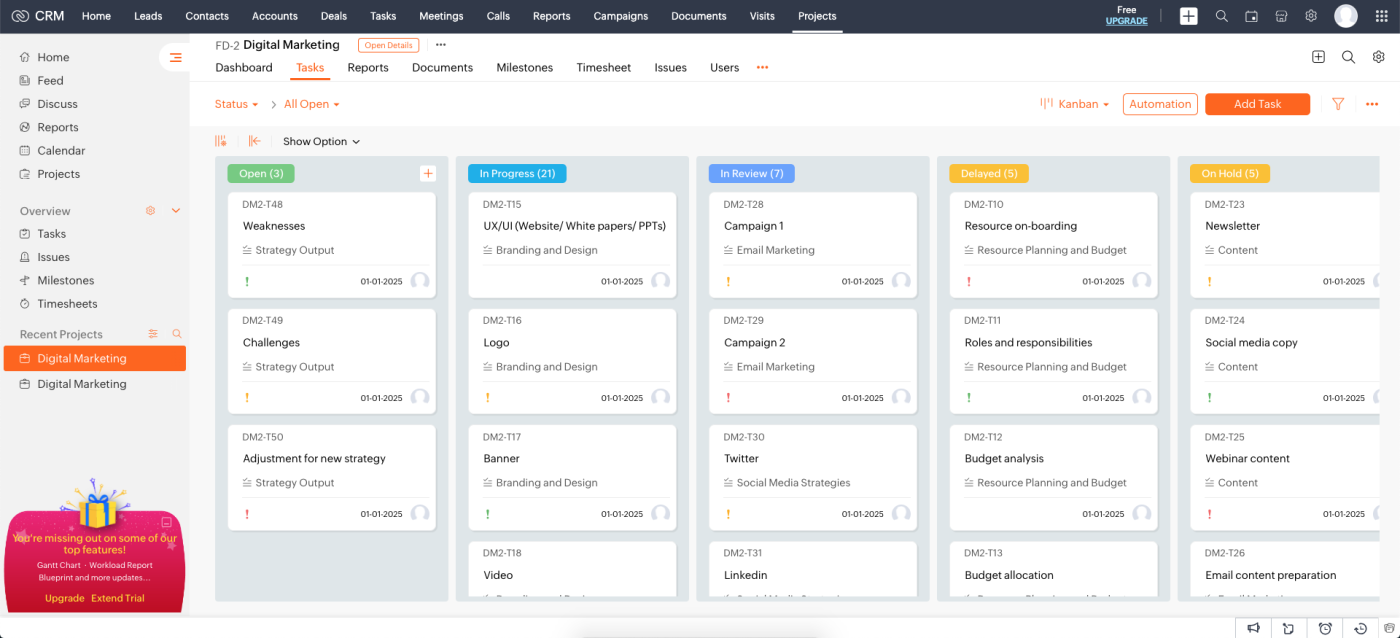
You can arrange tasks, milestones, and issues as Kanban boards or Gantt charts to suit your preferences or your team's organizational framework du jour, a la Agile or Scrum. (I wouldn't say its Kanban functionality is the cleanest I've ever seen, but it's a nice feature.) Overall, the dedicated task and issue tracking is well designed and nicely implemented, with plenty of options for adding, editing, and collaborating as issues move through the resolution process. Each integrates nicely with existing data from across the platform, like contacts, team members, tags, and schedules.
As part of the bigger CRM, the Projects dashboard makes task, ticketing, and issue tracking on an individual user basis a strength for Zoho.
Salesforce isn't necessarily deficient at any of the above. It also has a very nicely integrated task management system that can be easily accessed from the handy To Do List widget on the bottom nav bar.
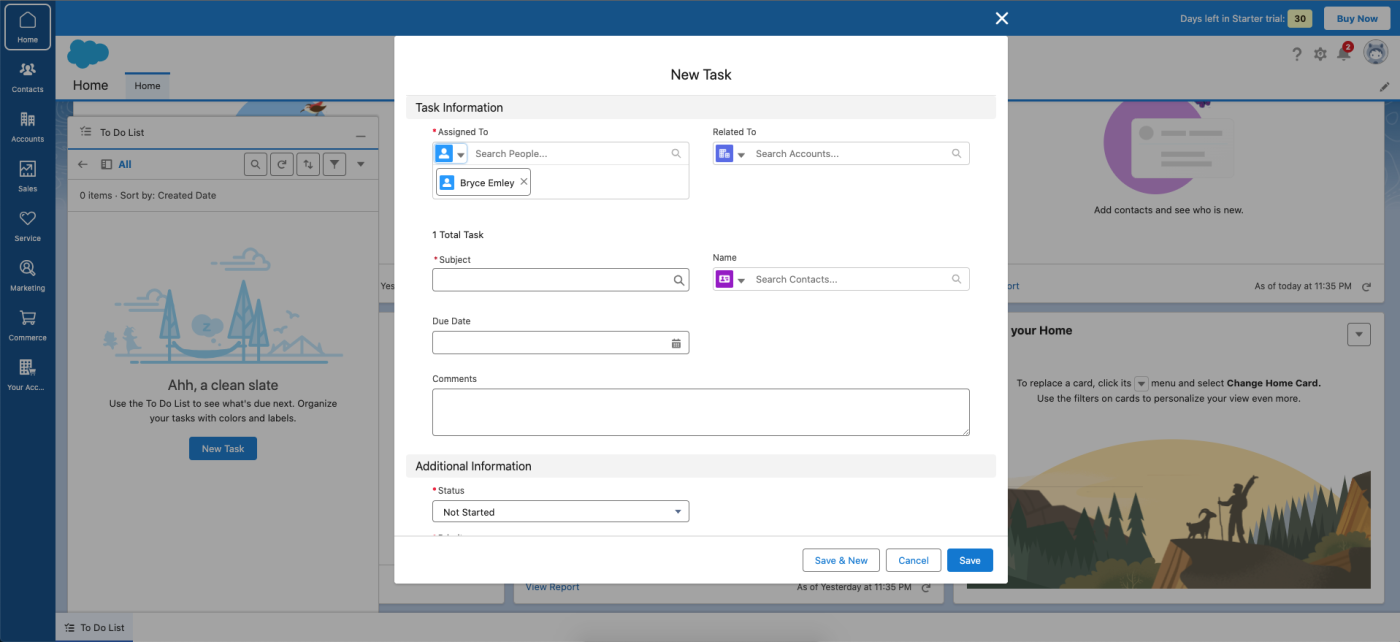
But Salesforce isn't designed to integrate issues as separate modules the way Zoho is. I also just generally prefer how Zoho has a separate dashboard from its main dashboard dedicated to the daily grind of managing issues, tasks, and milestones—though that's probably just personal preference.
On a practical level—and for the things I think many users will spend the bulk of their time doing in a CRM—I prefer the simplicity of Zoho.
Salesforce is more customizable and scalable, but Zoho is still a decent enterprise option
Scalability could be a key differentiator for some businesses. Zoho's simplicity may make it better suited for small- to medium-sized ones, though there are some big-name brands like Nike and Marriott that use its Enterprise offering to power campaign automation, omnichannel communication, and even AI.
Zoho's cloud suite offers several options for growing businesses, so it's definitely no slouch when it comes to scaling. Its nearly 60 native applications include sales and marketing tools, HR and legal solutions, IT and business intelligence offerings, and more. It even offers app builders like low-code Zoho Creator and Zoho Catalyst for creating and implementing serverless applications (at a lower cost than Salesforce's comparable applications).
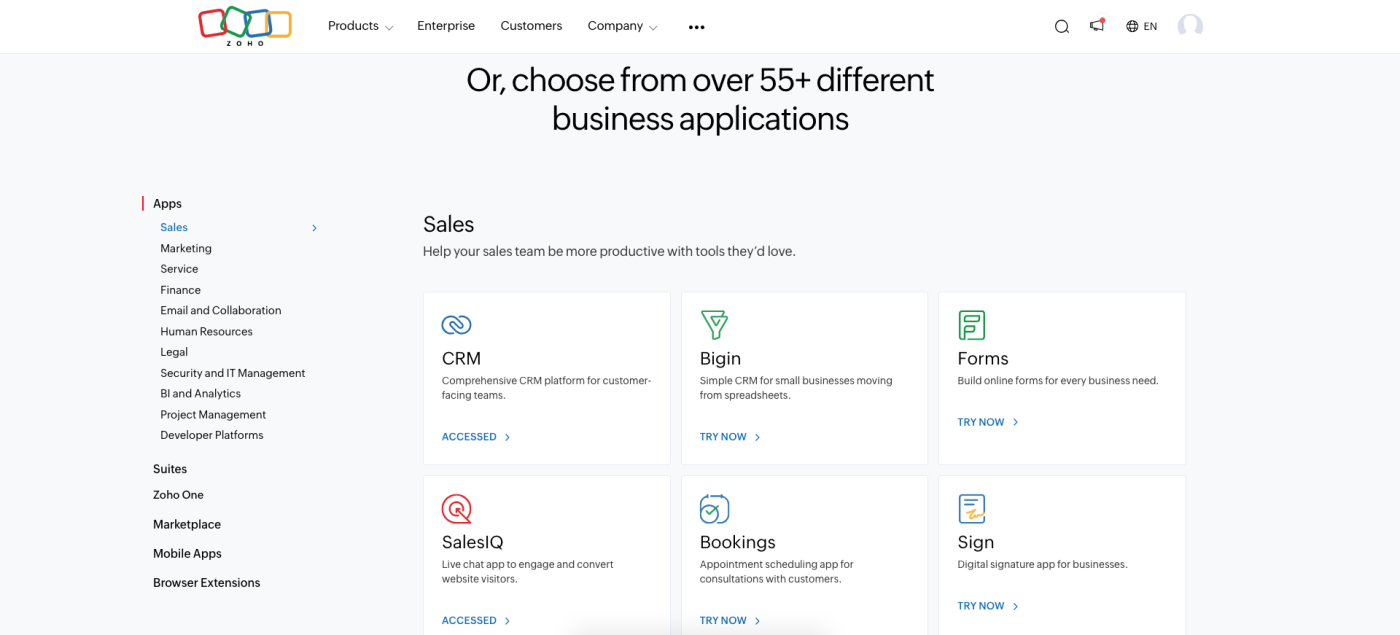
At just about any level, Zoho is functional as a pure CRM, but as utilization needs become more complex, even these customization options and supplementary solutions may not be robust enough for everyone at the enterprise level. This is where Salesforce thrives.
Salesforce isn't just a CRM with a lot of product options—it's an entire business universe. Like Zoho, Salesforce has lots of native applications in its ecosystem, as well as a bustling AppExchange marketplace where users can connect with partnered consultants to help find and implement the right apps. While Zoho also has a decent app marketplace, Salesforce has access to several thousand more third-party apps.
Like Zoho, Salesforce has product packages catered to specific use cases like sales, marketing, eCommerce, and customer support. It also offers more specific products like industry-based cloud solutions, net-zero sustainability management, custom analytics solutions, and connected experience integration.

For really dedicated users, Salesforce also hosts live events, workshops, and webinars. It even launched a business streaming platform called Salesforce+, where users can watch exclusive series and stream live events. Whether users plan to do a lot of Salesforce streaming or not, these efforts, at the very least, show that Salesforce is still a thought leader in the industry with plenty of educational resources.
Zoho wins at basic automation
In terms of traditional trigger-based automation sequences, Zoho is the winner for me. Zoho automation is pretty functional at even the Standard level for instant actions, with higher tiers (again, maxing at $65 per user per month), adding features like scheduled actions, webhooks, custom functions, auto-responders, and segmentation. Its trigger sequence builder isn't my favorite since it's not a drag-and-drop interface (though Zoho Marketing Automation is much sleeker), but it looks how you'd expect and isn't terribly difficult to figure out and integrate.
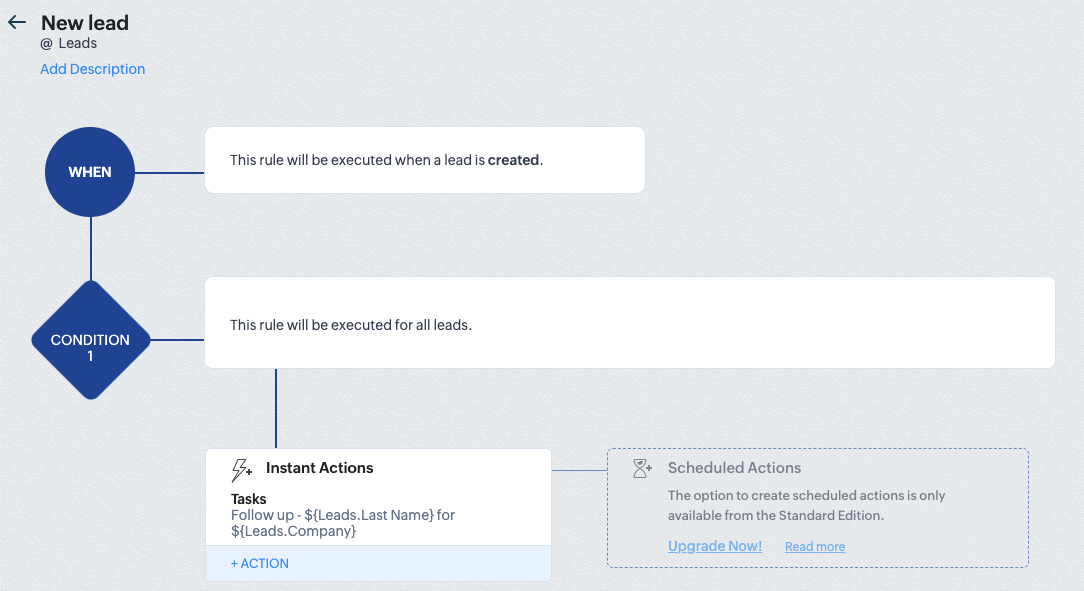
Salesforce, on the other hand, gatekeeps a lot of its automation functionality. You may find you need to upgrade to their four-figure-a-month Marketing cloud option to get the kind of high-end automation you need. Sales Cloud gives you limited automation trigger options in its lower packages, but you gain more advanced automation flows at the Professional tier and above.
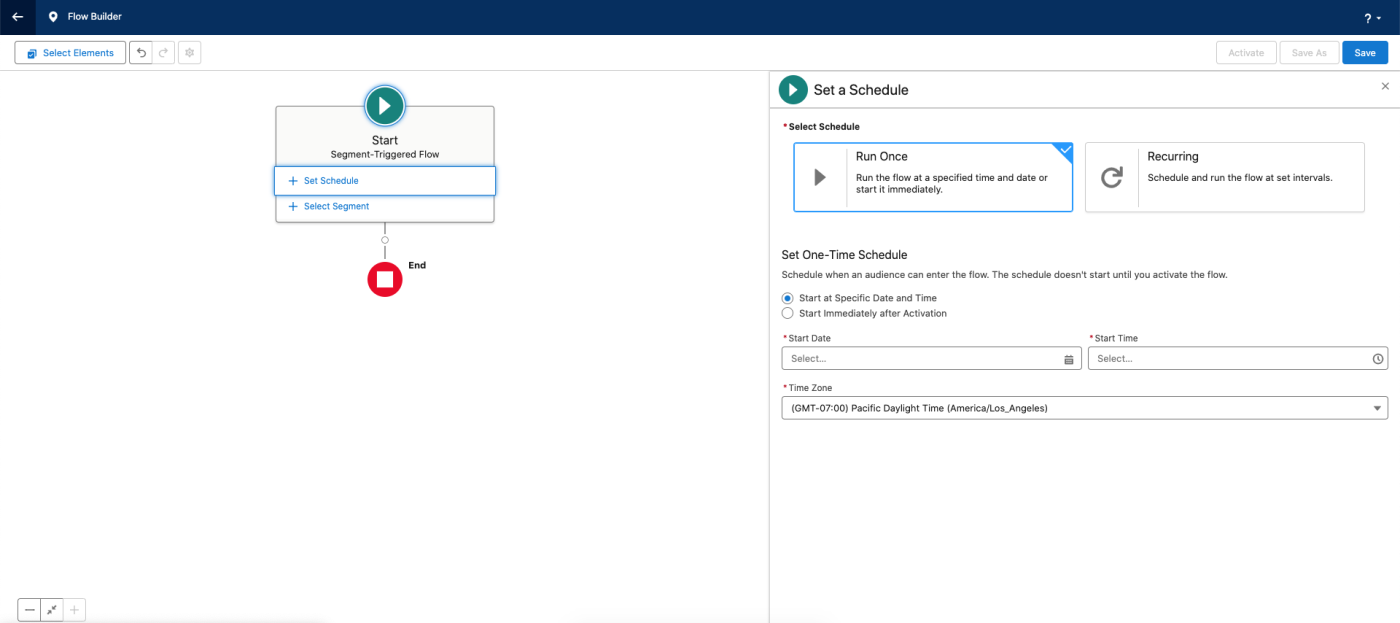
Both have similar AI assistants—but Zoho's is cheaper
It's no secret that AI is powering just about everything, from (hilariously) art to (unfortunately) journalism to (fortunately) IT operations. Your CRM solution shouldn't be an exception. Salesforce has a clear advantage there, but Zoho's not far behind.
Zoho's had an AI assistant called Zia for years. In its earlier days, it was basically a glorified business Siri, but today it offers more sophisticated capabilities like best-time-to-contact detection, automated anomaly detection, custom report creation, intelligent forecasting, data scraping, streamlined contact updating, and customer-facing product recommendations. Zia can even analyze activity history to suggest automation opportunities—which it can then deploy. Service agents can use both voice and text prompts to get customer info on the fly, and users can get AI-powered insights into sales performance when it comes time for reporting. It's like having your own personal AI assistant who can do basically everything you need, short of physically handing you coffee.
Purportedly parents of "the world's first generative AI for CRM," Salesforce offers Sales Cloud users access to Einstein GPT, essentially an AI assistant that also writes. (You'll just need to pony up $75 per user per month or upgrade to Einstein 1 Sales for $500.)
Einstein can assist in automating scheduling, generating data-driven insights, synthesizing data, applying machine learning, generating code, and more. All great, but the real draw is that it also creates dynamic content using natural language processing via OpenAI integration and Salesforce's private AI modeling. That means that your robo-assistant in Salesforce can also intelligently create context-based content across channels—including blog posts, knowledge libraries, messaging, and chat.
While Salesforce may have created the first generative AI for a CRM, Zoho caught up quickly. Zia also offers generative tools for writing customer responses, drafting documents, and generating charts. Since these tools are pretty comparable, I give Zoho the edge since Salesforce's costs more per user as an add-on than Zoho's most expensive subscription tier.
Zoho vs. Salesforce: Which is best for you?
I personally think choosing between Zoho vs. Salesforce is pretty simple:
If you plan to add complex cloud solutions and app integrations across teams for a range of use cases—and you have the budget for an expansive enterprise option—go with Salesforce.
If you want to start with a more affordable but very functional CRM that's better for individual task or issue management, pick Zoho.
In my experience, complexity and scalability are the key differences between the two options. I found Zoho a little more user-friendly for day-to-day task tracking, and its dedication to issue management could be a big plus for some users who want to extend their sales software to their support teams. Both have comparable AI and automation features, but Zoho offers them at value pricing.
If you're still stuck, the good news is both platforms integrate with Zapier for additional no-code automation capabilities. You can learn how to automate Salesforce and Zoho CRM to create your own custom workflows, or jump right in with one of these pre-made workflow templates.
Add new Facebook Lead Ads leads as leads in Salesforce
Create Salesforce leads with new Gravity Forms submissions
Create contacts on Zoho CRM from new leads from Facebook Lead Ads
Add new Unbounce form submissions to Zoho CRM as leads
Zapier is the leader in workflow automation—integrating with 6,000+ apps from partners like Google, Salesforce, and Microsoft. Use interfaces, data tables, and logic to build secure, automated systems for your business-critical workflows across your organization's technology stack. Learn more.
Zoho vs. Salesforce: FAQs
Still on the fence between Zoho vs. Salesforce? The answers to these commonly asked questions may help you decide which CRM is right for you.
Is Zoho or Salesforce better?
Zoho is a better choice for users who want bargain pricing, while Salesforce is better for those who want to scale their CRM at the enterprise level. Zoho's features are pretty comparable to many of Salesforce's but come at much cheaper pricing tiers, though advanced enterprise-level users may outgrow it.
What should I look for in a CRM?
The key features of a CRM will vary depending on the size of your business and needs. For example, a small business owner who's just starting out might prioritize free CRM software, whereas an established small business owner might need a CRM that's good for scaling a business.
For the top options, check out this list of the best CRM software.
Does Zoho have a free version?
Zoho doesn't offer a free version of its CRM, but it does offer a 15-day free trial for any of their plans.
Does Salesforce have a free version?
Similar to Zoho, there's no free version of Salesforce. But you can try out the Starter Suite or Enterprise plan for free for 30 days.
Related reading:
This article was originally published in June 2023. The most recent update was in June 2024.
